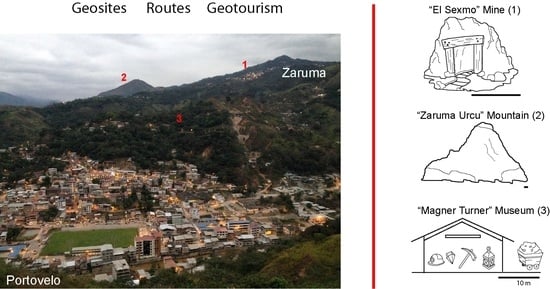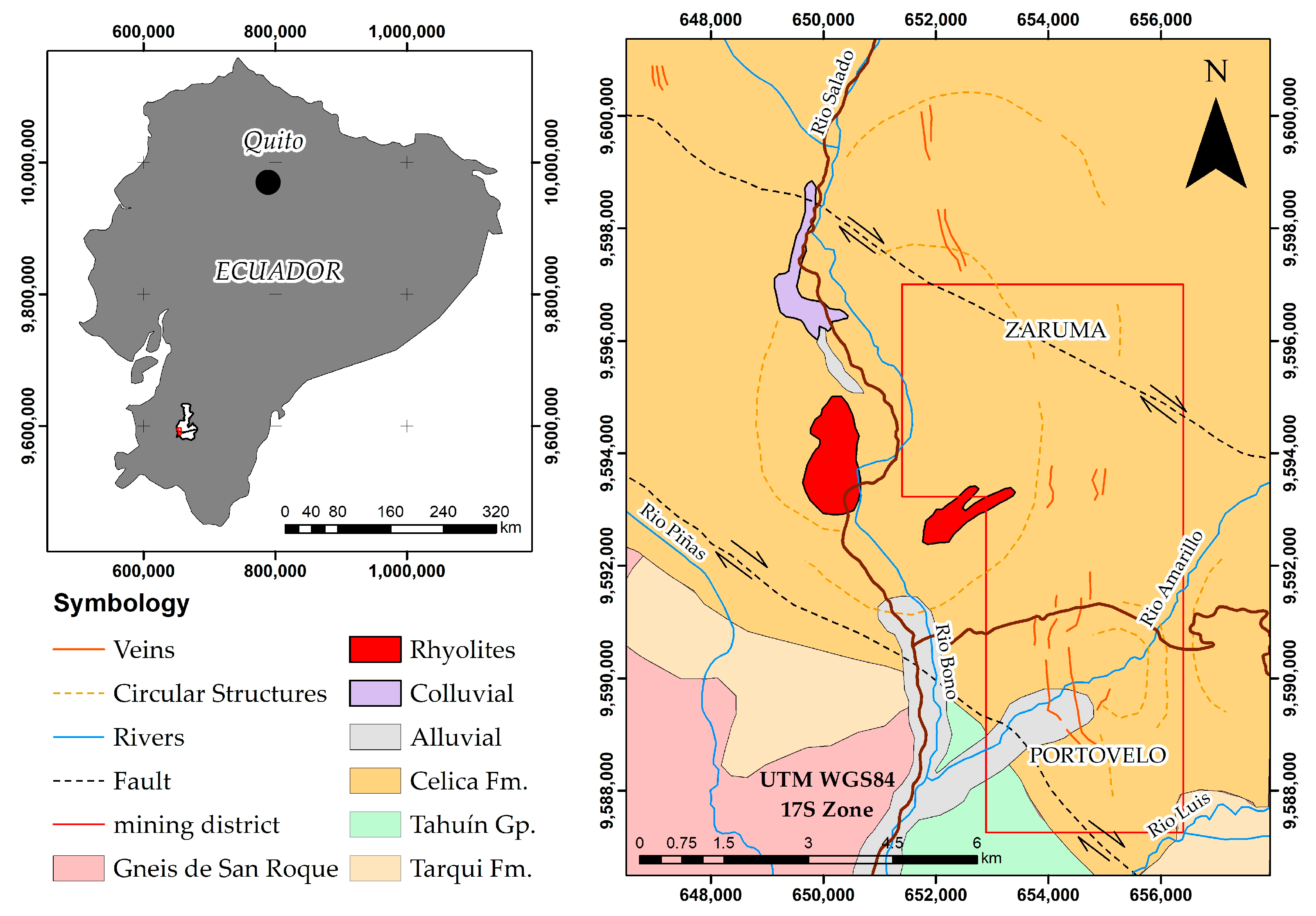Assessment and Promotion of Geotouristic and Geomining Routes as a Basis for Local Development: A Case Study
Abstract
1. Introduction
2. Study Zone Setting
3. Materials and Methods
4. Results
4.1. Selection of Information
4.2. Quantitative Assesment
Assessment of Pending Geosites by IELIG Method
4.3. Quantitative Analysis and Assesment
Route Assessment by GtRAM Method
- GtRAM applied to the GT-I route
- GtRAM applied to the GT-II route
- GtRAM applied to the GM-III route
4.4. New Route and Strategies
4.4.1. The Geodiversity Route
4.4.2. Strengths, Weaknesses, Opportunities and Threats (SWOT) Analysis
5. Interpretation of Results and Discussion
6. Conclusions
Supplementary Materials
Author Contributions
Funding
Data Availability Statement
Acknowledgments
Conflicts of Interest
References
- Duxbury, N.; Bakas, F.E.; Vinagre de Castro, T.; Silva, S. Creative Tourism Development Models towards Sustainable and Regenerative Tourism. Sustainability 2020, 13, 2. [Google Scholar] [CrossRef]
- Ciftci, Y.; Güngör, Y. Proposals for the Standard Presentation of Elements of Natural and Cultural Heritage Within the Scope of Geopark Projects. Bull. Miner. Res. Explor. 2016, 153, 223–238. [Google Scholar] [CrossRef]
- Frækaland Vangsnes, G. The meanings of mining: A perspective on the regulation of artisanal and small-scale gold mining in southern Ecuador. Extr. Ind. Soc. 2018, 5, 317–326. [Google Scholar] [CrossRef]
- Carcavilla, L.; Durán, J.J.; López-Martínez, J. Geodiversidad: Concepto y relación con el patrimonio geológico. Geo-Temas 2008, 10, 1299–1303. [Google Scholar]
- Carcavilla, L.; Belmonte, Á.; Durán, J.J.; Hilario, A. Geoturismo: Concepto y perspectivas en España. Enseñ. Cienc. Tierra 2011, 19, 81–94. [Google Scholar]
- Hose, T.A. 3G’s for Modern Geotourism. Geoheritage 2012, 4, 7–24. [Google Scholar] [CrossRef]
- Dowling, R.K.; Newsome, D. Geotourism: The Tourism of Geology and Landscape; Goodfellow Publishers: Oxford, UK, 2010; ISBN 978-1-906884-09-3. [Google Scholar]
- Dowling, R.K. Global Geotourism—An Emerging Form of Sustainable Tourism. Czech J. Tour. 2013, 2, 59–79. [Google Scholar] [CrossRef]
- Newsome, D.; Dowling, R.; Leung, Y.-F. The nature and management of geotourism: A case study of two established iconic geotourism destinations. Tour. Manag. Perspect. 2012, 2–3, 19–27. [Google Scholar] [CrossRef]
- Liverman, D. Geodiversity—Valuing and Conserving Abiotic Nature. Can. Geogr./Géogr. Can. 2006, 50, 412–413. [Google Scholar] [CrossRef]
- Mazzoni, E.; Diez, P. Potencialidad del geoturismo en la Patagonia: Sitios de interés geológico en proximidad de la Ruta Nacional 40, tramo Río Turbio—Lago Viedma, Santa Cruz. Ser. Correl. Geol. 2018, 34, 56–79. [Google Scholar]
- Declaración de Arouca. Available online: http://www.europeangeoparks.org/?p=223 (accessed on 24 March 2021).
- Brilha, J. Inventory and Quantitative Assessment of Geosites and Geodiversity Sites: A Review. Geoheritage 2016, 8, 119–134. [Google Scholar] [CrossRef]
- Palacio Prieto, J.L. Geositios, geomorfositios y geoparques; importancia, situación actual y perspectivas en México. Investig. Geogr. 2013, 2013, 24–37. [Google Scholar] [CrossRef]
- Mirari, S.; Aoulad-Sidi-Mhend, A.; Benmlih, A. Geosites for Geotourism, Geoheritage, and Geoconservation of the Khnefiss National Park, Southern Morocco. Sustainability 2020, 12, 7109. [Google Scholar] [CrossRef]
- Prosser, C.D.; Díaz-Martínez, E.; Larwood, J.G. The Conservation of Geosites. In Geoheritage; Elsevier: Amsterdam, The Netherlands, 2018; pp. 193–212. [Google Scholar]
- Nita, J.; Myga-Piateck, U. Geotourism potential of post-mining regions in Poland. Bull. Geogr. 2014, 7, 138–156. [Google Scholar] [CrossRef]
- Sánchez-Cortez, J.L.; Simbaña-Tasiguano, M. Los geoparques y su implantación en América Latina. Estud. Geogr. 2019, 79, 445. [Google Scholar] [CrossRef]
- Carrillo Cevallos, F.H. Planeamiento Geológico Minero Aplicado al Desarrollo Sustentable a la Ruta del Oro. Bachelor’s Thesis, The Escuela Superior Politécnica del Litoral (ESPOL), Guayaquil, Ecuador, 2009. [Google Scholar]
- Cantero-Quesada, J.M. Territorio, turismo y senderos temáticos: El caso de Baños de la Encina, Jaén. In Patrimonio Cultural y Desarrollo Territorial; Thomson Reuters Aranzadi: Cizur Menor, Spain, 2016; pp. 277–308. [Google Scholar]
- Palacio Prieto, J.L.; de Castro Martínez, G.F.; González, E.M.R. Geotrails in the mixteca alta UNESCO Global Geopark, Oaxaca, Mexico. Cuad. Geogr. 2019, 58, 111–125. [Google Scholar]
- Carrión-Mero, P.; Ayala-Granda, A.; Serrano-Ayala, S.; Morante-Carballo, F.; Aguilar-Aguilar, M.; Gurumendi-Noriega, M.; Paz-Salas, N.; Herrera-Franco, G.; Berrezueta, E. Assessment of Geomorphosites for Geotourism in the Northern Part of the “Ruta Escondida” (Quito, Ecuador). Sustainability 2020, 12, 8468. [Google Scholar] [CrossRef]
- Venzal, C.A. Tourism analysis of a geological route. Seven sections of the Trans-Pyrenean. Geological Route in Aspe valley (France). Cahiers de Geographie du Quebec 2013, 57, 333–357. [Google Scholar] [CrossRef][Green Version]
- Antić, A.; Pomić, N.; Dordević, T.; Marković, S.B. Promoting Palaeontological Heritage of Mammoths in Serbia Through a Cross-Country Thematic Route. Geoheritage 2021, 13, 1–16. [Google Scholar] [CrossRef]
- Nigmatova, S.; Zhamangara, A.; Bayshashov, B.; Abubakirova, N.; Akmagambet, S.; Berdenov, Z. Canyons of the charyn river (South-East Kazakhstan): Geological history and geotourism. Geoj. Tour. Geosites 2021, 34, 102–111. [Google Scholar] [CrossRef]
- Bouzekraoui, H.; Barakat, A.; El Youssi, M.; Touhami, F.; Mouaddine, A.; Hafid, A.; Zwoliński, Z. Mapping geosites as gateways to the geotourism management in central High-Atlas (Morocco). Quastiones Geogr. 2018, 37, 87–102. [Google Scholar] [CrossRef]
- Delgado-Martínez, A.M.; Pantoja-Timarán, F. Structural analysis for the identification of key variables in the Ruta del Oro, Nariño Colombia. Dyna 2015, 82, 27–33. [Google Scholar] [CrossRef]
- Pereira, M.B.; Ferreira, A.C.; Rocha, L.C. Trilha Interpretativa Geoturística na Serra de São José no Entorno da Estrada Real/MG. Anuário Inst. Geociênc. UFRJ 2012, 35, 165–172. [Google Scholar] [CrossRef]
- Carrion-Mero, P. Proyecto Rumys: Cooperación y Sostenibilidad. In La Plata en Iberoamérica, Siglos XVI al XIX: Congreso Internacional; Universidad de León: León, Spain, 2008; pp. 687–700. [Google Scholar]
- González-Martínez, A.; Carvajal Gómez, D.J. Pasivos ambientales mineros y su valorización como recurso patrimonial. Ejemplo de actuaciones en la Comarca de Tharsis (Faja Pirítica Ibérica). In Taller Sostenibilidad; CETEM: Río de Janeiro, Brasil, 2013; pp. 5–29. [Google Scholar]
- Obiols-Perearnau, L.; Mata-Perelló, J.; Restrepo-Martínez, C.; Pasques-Canut, J. Rutas de la Sal. El “Camí Cardoner”, vía de distribución de la sal de las Minas de Cardona hacia el Sur de Francia. In Rutas Minerales en Iberoamérica; CYTED: Guayaquil, Ecuador, 2009; pp. 77–83. [Google Scholar]
- Pires, M. “A “Estrada Real” e a história do processo de construção de roteiros turísticos no estado de Minas Gerais, Brasi. Tur. Desarro. Local 2017, 10, 1–10. [Google Scholar]
- Mata-Perelló, J.; Carrión, P.; Molina, J.; Villas-Boas, R. Geomining Heritage as a Tool to Promote the Social Development of Rural Communities. In Geoheritage; Elsevier: Amsterdam, The Netherlands, 2018; pp. 167–177. [Google Scholar]
- Carrión Mero, P.; Herrera Franco, G.; Briones, J.; Caldevilla, P.; Domínguez-Cuesta, M.; Berrezueta, E. Geotourism and Local Development Based on Geological and Mining Sites Utilization, Zaruma-Portovelo, Ecuador. Geosciences 2018, 8, 205. [Google Scholar] [CrossRef]
- Ecuador. Asamblea Nacional Constituyente; Constitución Política del Ecuador: Quito, Ecuador, 2010. [Google Scholar]
- Ecuador. Asamblea Nacional; Ley Organica de Cultura: Quito, Ecuador, 2016. [Google Scholar]
- Ecuador. Asamblea Nacional; Código Orgánico del Ambiente: Quito, Ecuador, 2017. [Google Scholar]
- National System of Protected Areas (SNAP). Sistema Nacional de Áreas Protegidas del Ecuador. Minietrio del Ambiente y Agua. República del Ecuador. Available online: http://areasprotegidas.ambiente.gob.ec/es (accessed on 12 March 2021).
- Reyes Vargas, M.; Manjarrez Fuentes, N.; Ortega Ocaña, A. La Gestión del turismo comunitario en el marco de la economía popular y solidaria en Ecuador. Tur. Y Desarro. Local. 2014, 17, 3–9. [Google Scholar]
- Figueroa, M.F. El Control de Tráfico Ilícito de Bienes Culturales Patrimoniales, Normativa y Participación Legal de las Instituciones Públicas Correspondientes. Master’s Thesis, Instituto de Altos Estudios Nacionales (IAEN), Quito, Ecuador, 2005. [Google Scholar]
- Molina, E. Estudio comparativo de los sitios Ramsar en el Ecuador como oferta turística del Patrimonio Natural del Ecuador. Rev. Tur. Desarro. Buen Vivir 2012, 3, 45–81. [Google Scholar]
- Guzmán, T.L.G.; Trigo, J.P.; Gálvez, J.C.P.; Pesantez, S. El patrimonio inmaterial de la humanidad como herramienta de promoción de un destino turístico. Estud. Perspect. Tur. 2017, 26, 568–584. [Google Scholar]
- Arellano Guerrón, S.L.; Arroyo Mera, D.M.; Carrión Albuja, E.A.; Merizalde Leiton, C.E. Geoparques mundiales de la UNESCO y su importancia en el desarrollo sostenible de las comunidades. Estudio de caso: “Geoparque Imbabura”. Siembra 2019, 6, 93–108. [Google Scholar] [CrossRef]
- La Serna Gómez, A.M.; Rhea González, B.S.; Vasallo Villalonga, Y. Estrategias para el desarrollo sostenible y sustentable del Geoparque Imbabura, Ecuador. Explor. Digit. 2019, 1, 61–70. [Google Scholar] [CrossRef]
- Carrión, P.; Mata, J.; Romero, P.; Espinoza, T. Geoparque en Ecuador. In Proceedings of the Conference: Seminario Internacional sobre Patrimonio Geológico y Minero, Machala, Ecuador, 7–9 June 2012. [Google Scholar]
- Carrión-Mero, P.; Morante-Carballo, F. The Context of Ecuador’s World Heritage, for Sustainable Development Strategies. Int. J. Des. Nat. Ecodyn. 2020, 15, 39–46. [Google Scholar] [CrossRef]
- Herrera-Franco, G.; Carrión-Mero, P.; Morante-Carballo, F.; Herrera-Narváez, G.; Briones-Bitar, J.; & Blanco-Torrens, R. Strategies for the development of the value of the mining-industrial heritage of the Zaruma-Portovelo, ecuador, in the context of a geopark project. Int. J. Energy Prod. Manag. 2020, 5, 48–59. [Google Scholar] [CrossRef]
- Carrión-Mero, P.; Loor-Oporto, O.; Andrade-Ríos, H.; Herrera-Franco, G.; Morante-Carballo, F.; Jaya-Montalvo, M.; Aguilar-Aguilar, M.; Torres-Peña, K.; Berrezueta, E. Quantitative and Qualitative Assessment of the “El Sexmo” Tourist Gold Mine (Zaruma, Ecuador) as A Geosite and Mining Site. Resources 2020, 9, 28. [Google Scholar] [CrossRef]
- Schütte, P.; Chiaradia, M.; Barra, F.; Villagómez, D.; Beate, B. Metallogenic features of Miocene porphyry Cu and porphyry-related mineral deposits in Ecuador revealed by Re-Os, 40Ar/39Ar, and U-Pb geochronology. Miner. Depos. 2012, 47, 383–410. [Google Scholar] [CrossRef]
- Van Thournout, F.; Salemink, J.; Valenzuela, G.; Merlyn, M.; Boven, A.; Muchez, P. Portovelo: A volcanic-hosted epithermal vein-system in Ecuador, South America. Miner. Depos. 1996, 31, 269–276. [Google Scholar] [CrossRef]
- Kennerley, J.B. Hoja Geológica Zaruma 38 CT-NVI-E Escala 1:100,000; Instituto Geográfico Militar (Ed): Quito, Ecuador, 1980. [Google Scholar]
- Bonilla, W. Metalogenia del Distrito Minero Zaruma-Portovelo, República del Ecuador. Ph.D. Thesis, Universidad de Buenos Aires, Buenos Aires, Argentina, 2009. [Google Scholar]
- Berrezueta, E.; Ordóñez-Casado, B.; Bonilla, W.; Banda, R.; Castroviejo, R.; Carrión, P.; Puglla, S. Ore Petrography Using Optical Image Analysis: Application to Zaruma-Portovelo Deposit (Ecuador). Geosciences 2016, 6, 30. [Google Scholar] [CrossRef]
- Tarras-Wahlberg, N. Environmental management of small-scale and artisanal mining: The Portovelo-Zaruma goldmining area, southern Ecuador. J. Environ. Manag. 2002, 65, 165–179. [Google Scholar] [CrossRef]
- Chiaradia, M.; Fontboté, L.; Beate, B. Cenozoic continental arc magmatism and associated mineralization in Ecuador. Miner. Depos. 2004, 39, 204–222. [Google Scholar] [CrossRef]
- Schutzmeier, P.; Berger, U.; Bose-O’Reilly, S. Gold Mining in Ecuador: A Cross-Sectional Assessment of Mercury in Urine and Medical Symptoms in Miners from Portovelo/Zaruma. Int. J. Environ. Res. Public Health 2016, 14, 34. [Google Scholar] [CrossRef]
- Adler Miserendino, R.; Bergquist, B.A.; Adler, S.E.; Guimarães, J.R.D.; Lees, P.S.J.; Niquen, W.; Velasquez-López, P.C.; Veiga, M.M. Challenges to measuring, monitoring, and addressing the cumulative impacts of artisanal and small-scale gold mining in Ecuador. Resour. Policy 2013, 38, 713–722. [Google Scholar] [CrossRef]
- Veiga, M.M.; Angeloci, G.; Hitch, M.; Colon Velasquez-Lopez, P. Processing centres in artisanal gold mining. J. Clean. Prod. 2014, 64, 535–544. [Google Scholar] [CrossRef]
- Aguilar Aguilar, M.; Blanco Torrens, R.; Borja Bernal, C.; Briones Bitar, J.; Carrión Mero, P.; Morante Carballo, F. Caracterización geomecánica y análisis de las afectaciones del macizo rocoso en el casco urbano de Zaruma, Ecuador. In Proceedings of the 17th LACCEI International Multi-Conference for Engineering, Education, and Technology: “Industry, Innovation, and Infrastructure for Sustainable Cities and Communities”, Latin American and Caribbean Consortium of Engineering Institutions, Montego Bay, Jamaica, 24–26 July 2019. [Google Scholar]
- Villafuerte-Holguin, I.; Barrazueta-Quevedo, A. Desarrollo Turístico de la Ruta del Oro y su Área de Influencia en los Cantones Zaruma y Portovelo. Bachelor’s Thesis, The Escuela Superior Politécnica del Litoral (ESPOL), Guayaquil, Ecuador, 2005. [Google Scholar]
- Berrezueta-Alvarado, T. Análisis Turístico de la Ruta Zaruma Guizhaguiña. Bachelor’s Thesis, The Escuela Superior Politécnica del Litoral (ESPOL), Guayaquil, Ecuador, 2006. [Google Scholar]
- García, A.; Carcavilla, L. Documento Metodológico para la Elaboración del Inventario Español de Lugares de Interés Geológico (IELIG); Inventario Español de Lugares de Interés Geológico (IELIG): Madrid, Spain, 2014. [Google Scholar]
- Morante-Carballo, F.; Herrera-Narváez, G.; Jiménez-Orellana, N.; Carrión-Mero, P. Puyango, Ecuador Petrified Forest, a Geological Heritage of the Cretaceous Albian-Middle, and Its Relevance for the Sustainable Development of Geotourism. Sustainability 2020, 12, 6579. [Google Scholar] [CrossRef]
- Carrión-Mero, P.; Morante-Carballo, F.; Apolo-Masache, B. Evaluation of geosites as an alternative for geotouristic development in Guayaquil, Ecuador. Wit Trans. Ecol. Environ. 2020, 241, 45–56. [Google Scholar] [CrossRef]
- Herrera-Franco, G.; Carrión-Mero, P.; Alvarado, N.; Morante-Carballo, F.; Maldonado, A.; Caldevilla, P.; Briones-Bitar, J.; Berrezueta, E. Geosites and Georesources to Foster Geotourism in Communities: Case Study of the Santa Elena Peninsula Geopark Project in Ecuador. Sustainability 2020, 12, 4484. [Google Scholar] [CrossRef]
- Herrera-Franco, G.; Montalván-Burbano, N.; Carrión-Mero, P.; Apolo-Masache, B.; Jaya-Montalvo, M. Research trends in geotourism: A bibliometric analysis using the scopus database. Geosciences 2020, 10, 379. [Google Scholar] [CrossRef]
- Paungya, N.; Singtuen, V.; Won-In, K. The preliminary geotourism study in Phetcahbun Province, Thailand. Geoj. Tour. Geosites 2020, 31, 1057–1067. [Google Scholar] [CrossRef]
- Corbí, H.; Fierro, I.; Aberasturi, A.; Ferris, E.J.S. Potential Use of a Significant Scientific Geosite: The Messinian Coral Reef of Santa Pola (SE Spain). Geoheritage 2018, 10, 427–441. [Google Scholar] [CrossRef]
- Martínez-Miranda, G.M. Identificar, caracterizar y evaluar sitios geoculturales. Trabajo de campo en el Geoparque Mundial UNESCO Mixteca Alta. Investig. Geogr. 2018, 97, 1–11. [Google Scholar] [CrossRef]
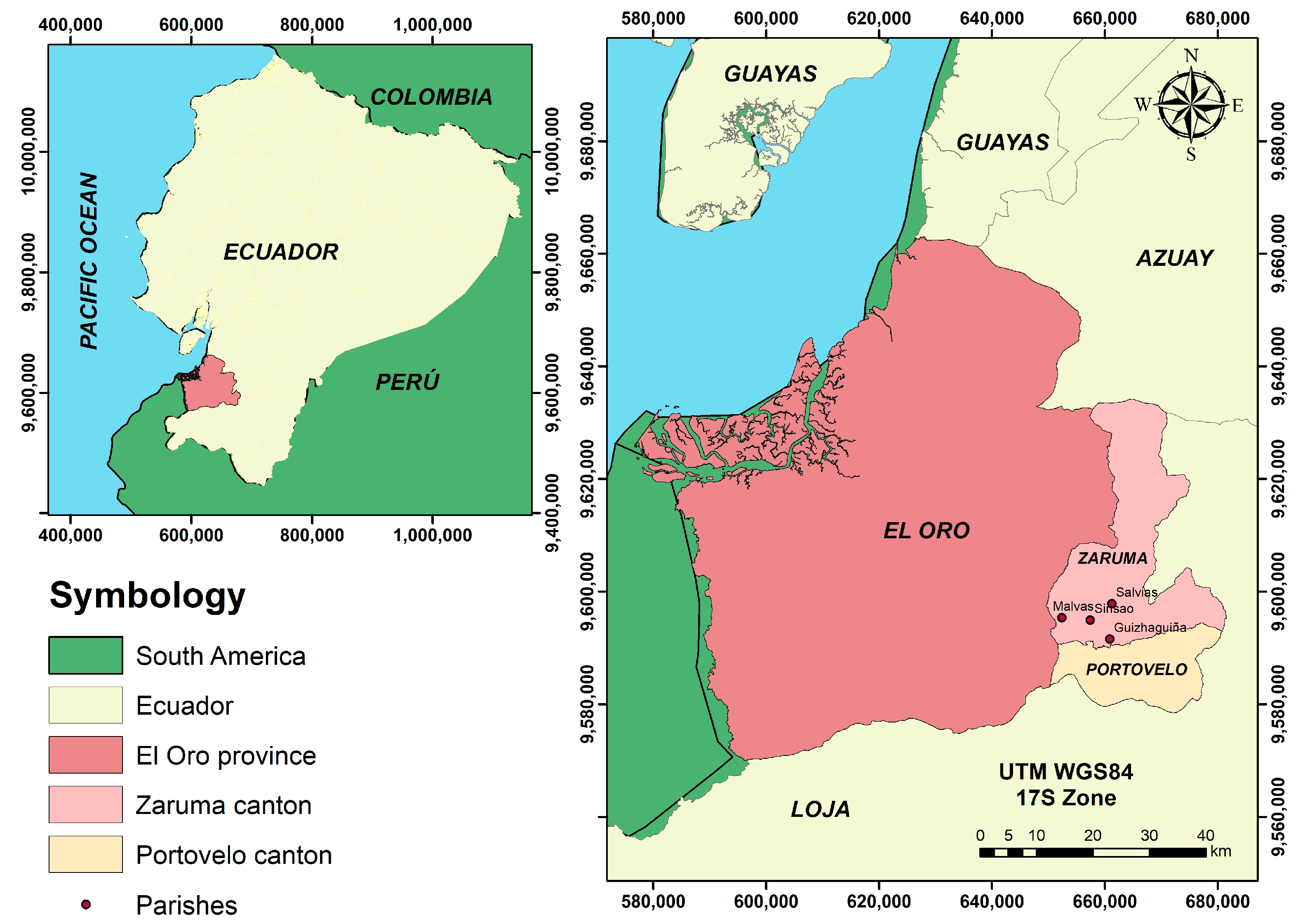
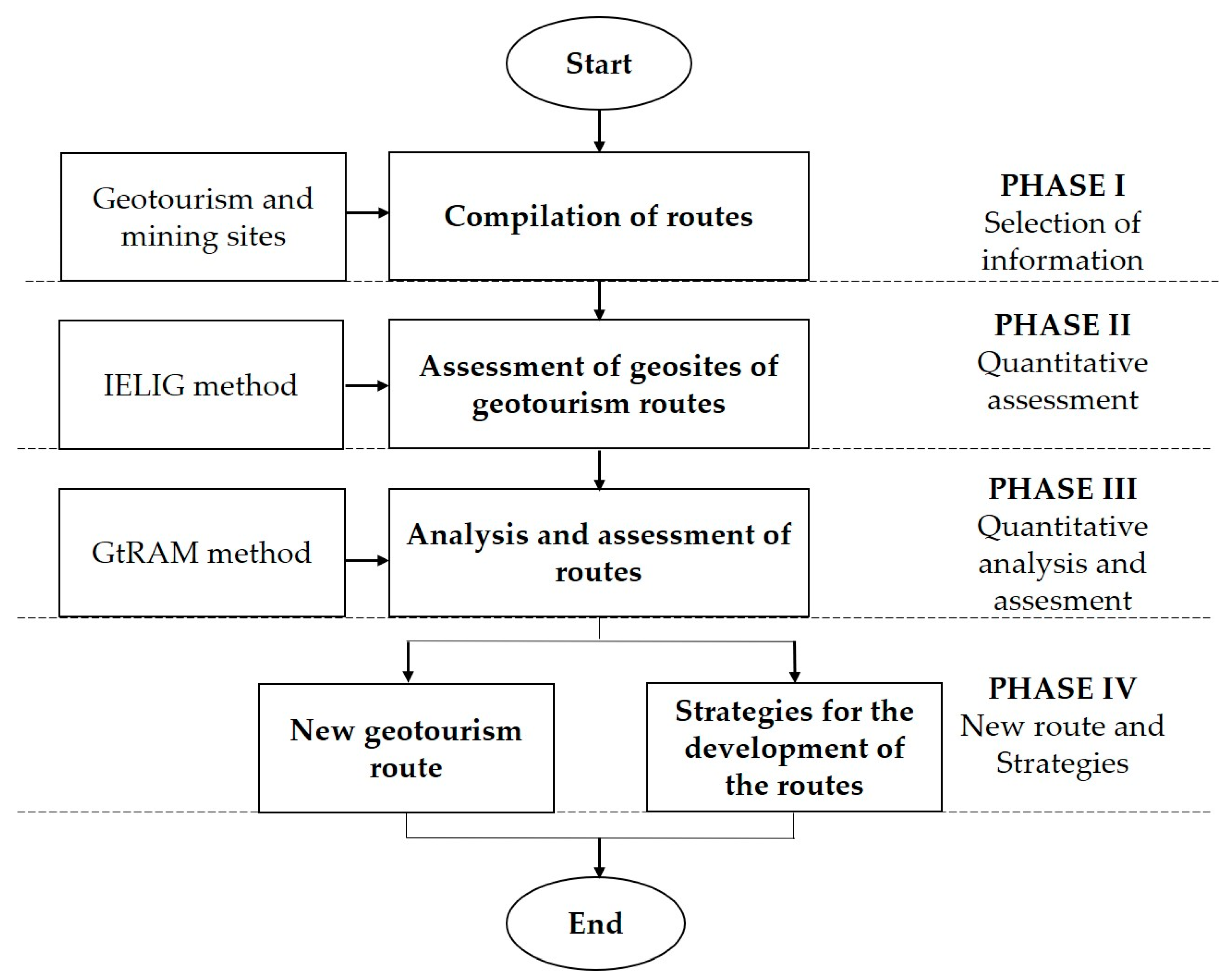
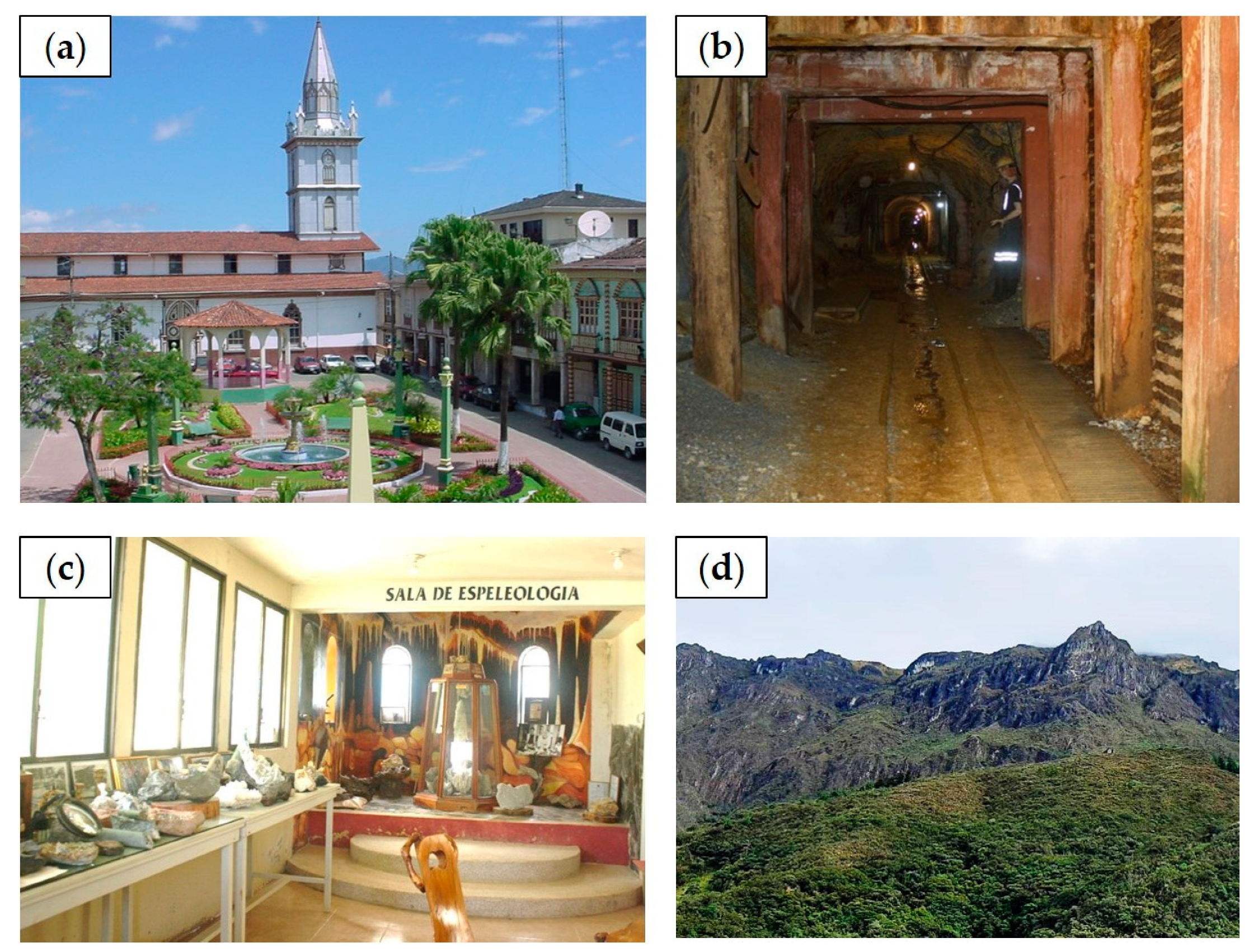
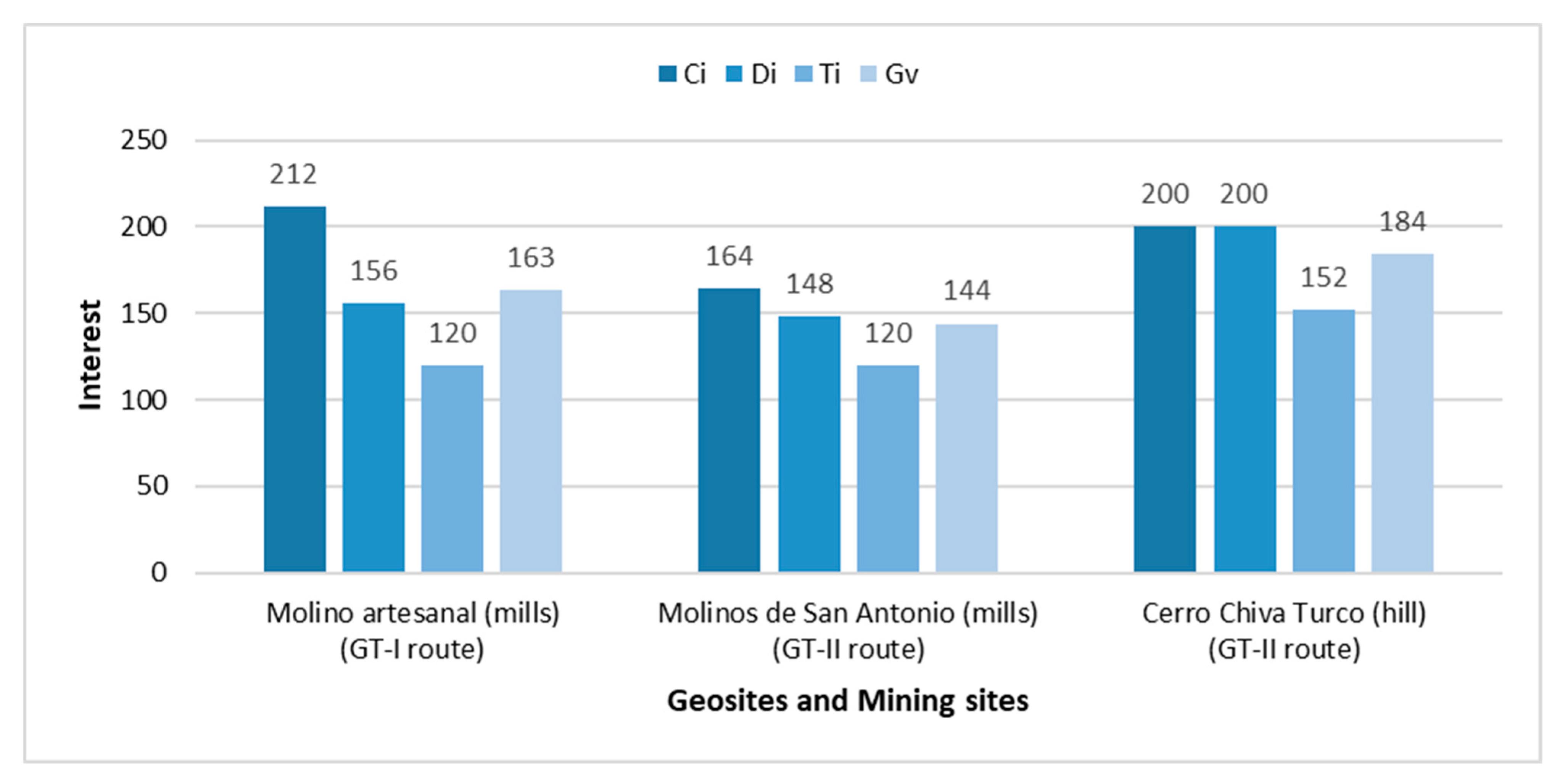
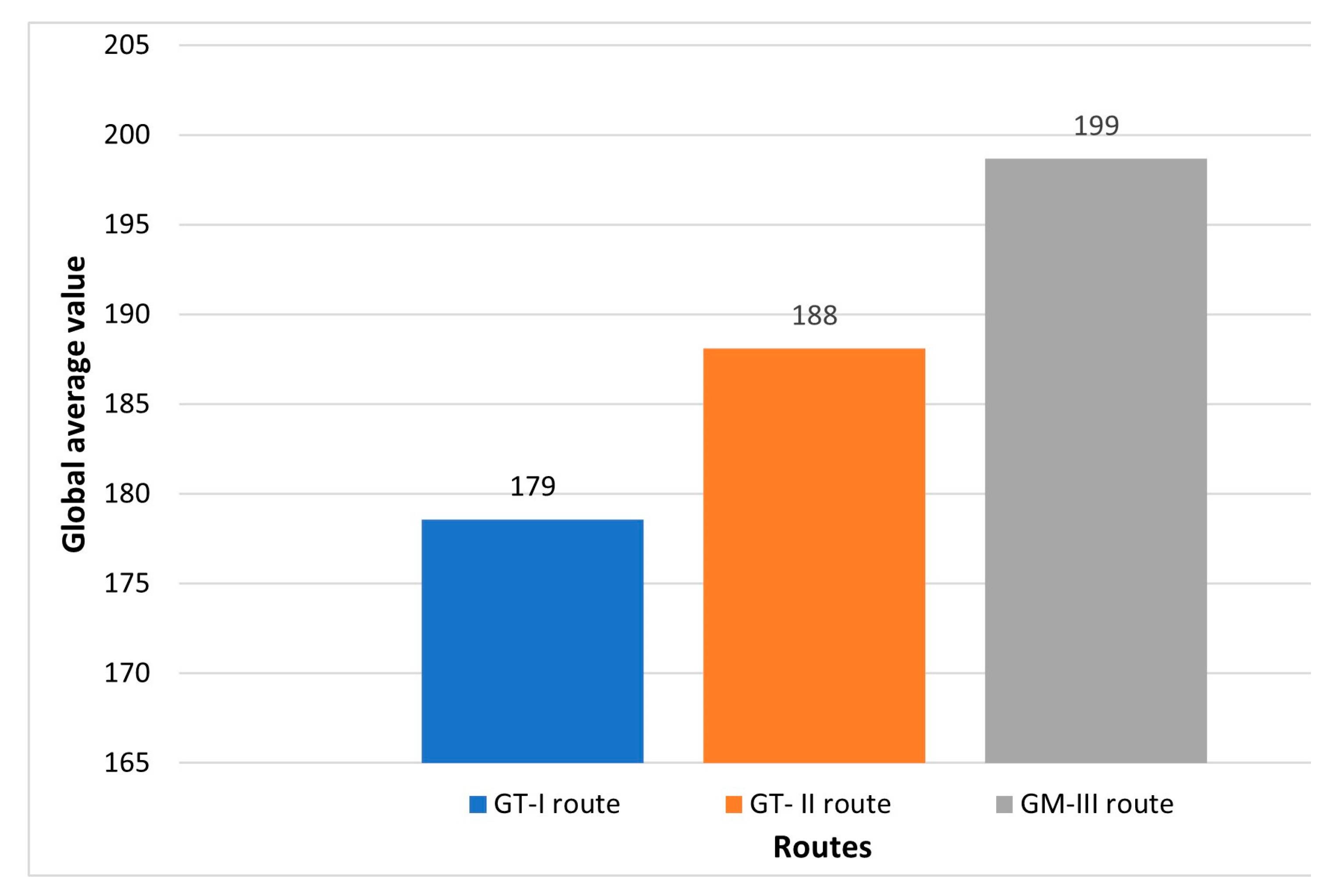
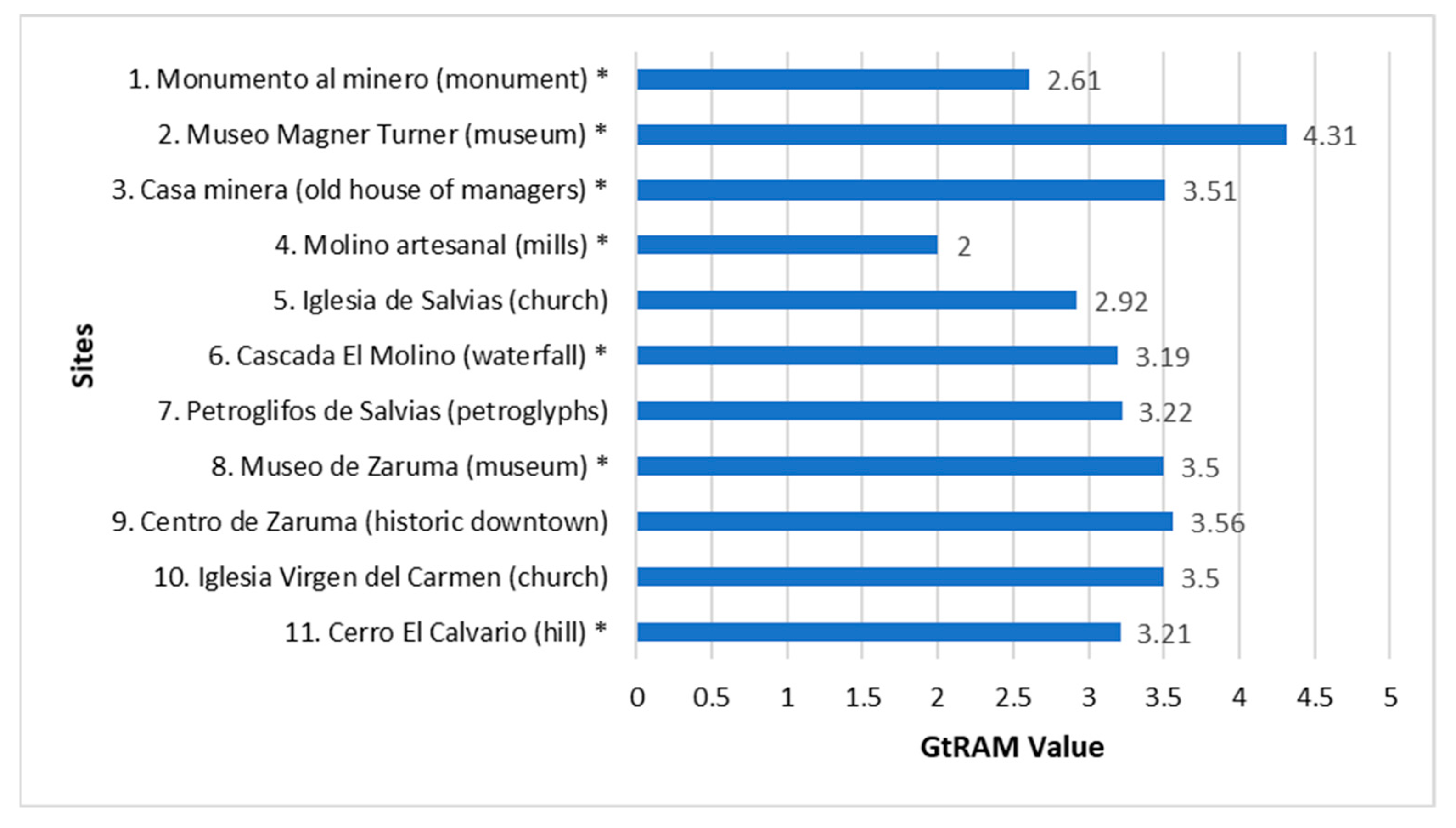
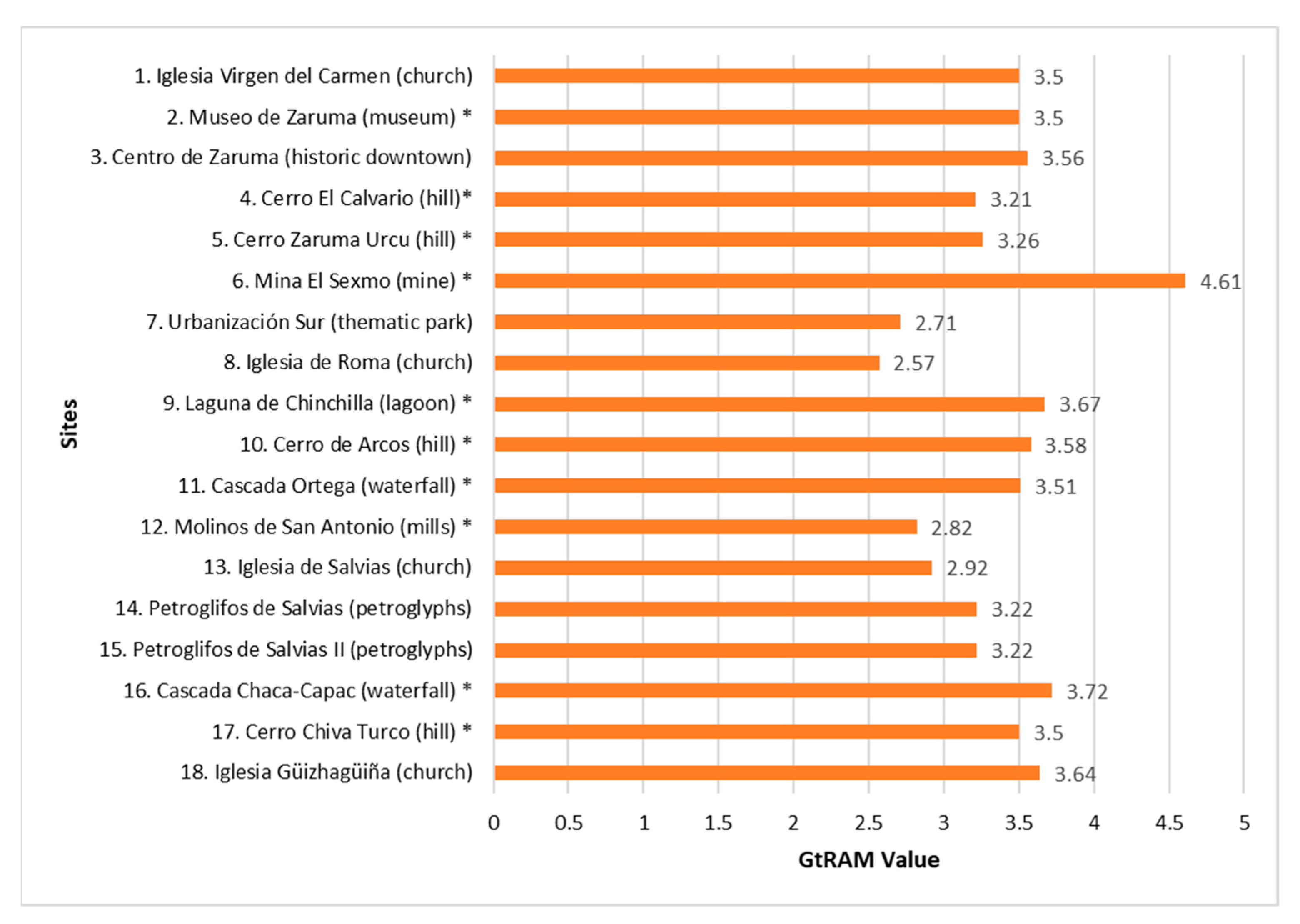

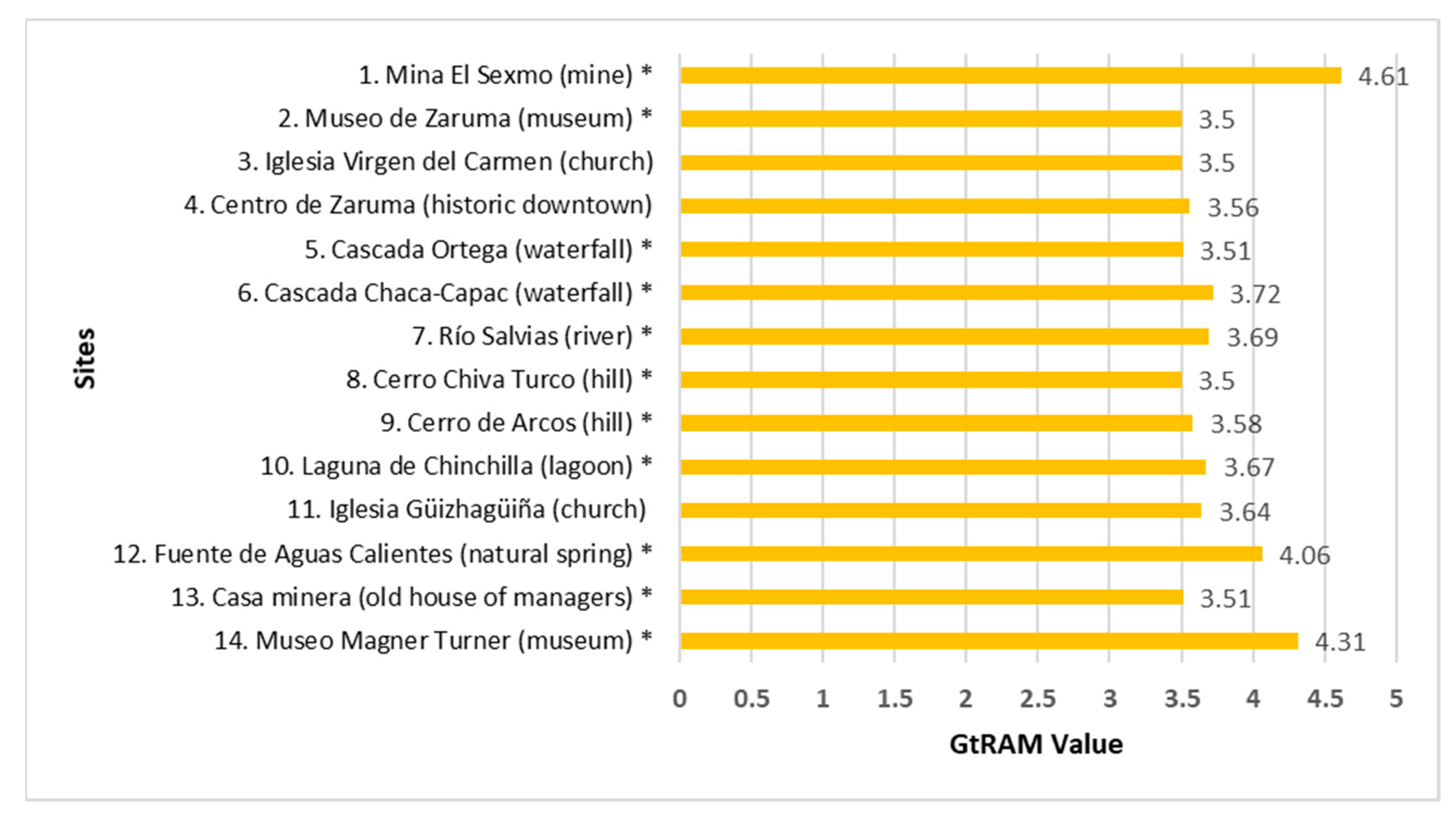
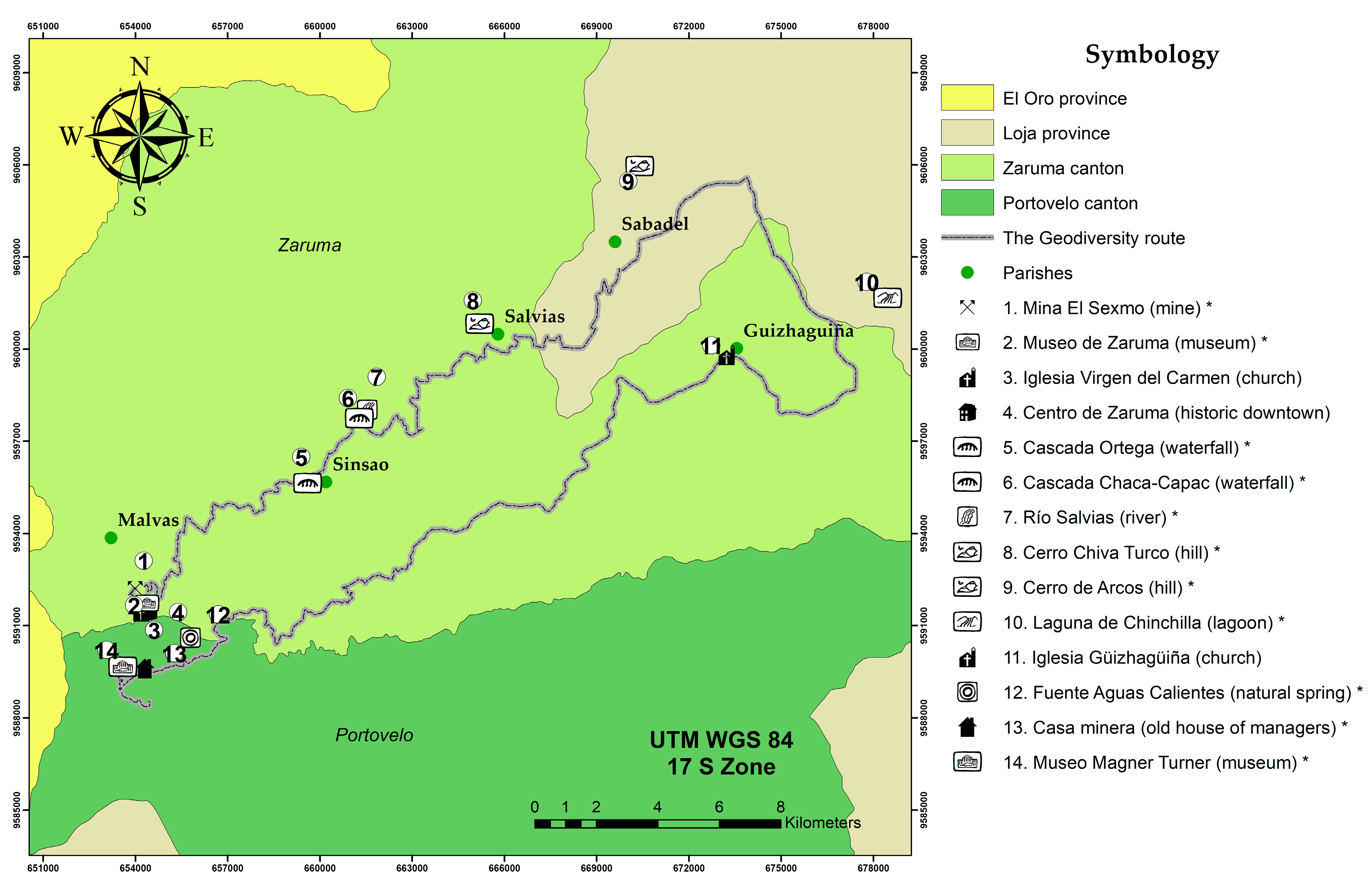
| Qualitative Parameters | Value Range | Elements to Consider |
|---|---|---|
| Accessibility | 1–5 | Main roads Parking spaces Access by other types of transport (bicycle path, rail) |
| Preparation and logistics | Presence of signage Trained tourist guides Basic services (hotels, restaurants) | |
| Registration with the Ministry of Tourism | Tourist registration application entry Accommodation economic activities requirements Recreation fun and recreation | |
| Regarding Heritage | Presence of human and cultural values of a particular historic period Presence of natural habitats | |
| Contribution to scientific knowledge | Research studies in the area (scientific articles) Promotes knowledge in science Promotes the implementation of research proposals (theme parks, museums, sites, geopark, geotourism) | |
| Ecotourism | Environmental awareness campaigns Activities that reduce the environmental impactSignage and information about environmental care at the sites |
| Routes | Sites | Site Type/Interest | Location |
|---|---|---|---|
| GT-I (Figure S1 in the Supplementary Material) |
| Mining | Portovelo |
| Mining | ||
| Mining | ||
| Mining | ||
| Architectural | Zaruma | |
| Geological | ||
| Archaeological | ||
| Mining | ||
| Architectural | ||
| Architectural | ||
| Geological | ||
| GT-II(Figure S2 in the Supplementary Material) |
| Architectural | Zaruma |
| Mining | ||
| Architectural | ||
| Geological | ||
| Geological | ||
| Geological | ||
| Variable | ||
| Architectural | ||
| Geological | ||
| Geological | ||
| Geological | ||
| Geological | ||
| Architectural | ||
| Archaeological | ||
| Archaeological | ||
| Geological | ||
| Geological | ||
| Architectural | ||
| GM-III(Figure S3 in the Supplementary Material) |
| Mining | Zaruma |
| Geological | ||
| Mining | Portovelo | |
| Geological | ||
| Geological | Zaruma | |
| Geological |
| Route | Length (Km) | Degree of Difficulty | Addressees | Level of Safety | Accessibility |
|---|---|---|---|---|---|
| GT-I | 37.06 | Low | Individual tourists and organized groups | High | Main order roads |
| GT-II | 113.32 | High | Individual tourists and organized groups | High | Main and secondary order roads and pedestrian paths. |
| GM-III | 63.59 | Medium | Individual tourists and organized groups | High | Main and secondary order roads and pedestrian paths. |
| Internal Aspects | Strengths | Weaknesses | |
| External Aspects | S1. The proposed route covers possible geosites and mining sites of historical, mining, natural and cultural relevance. S2. Recreational and educational activities related to geosciences. S3. Low-cost tour with tourist guides included. S4. Zaruma and Portovelo are national heritages of Ecuador. In addition, Zaruma was declared a magical town of Ecuador. | W1. Lack of conservation policies for potential geosites and mining sites. W2. The logistics are unfavourable on the primary and secondary roads of the route. W3. The entire route must be done by vehicle due to the distance from the sites. W4. Restricted access in mining interest sites because they are private property such as processing plants and lack of security protocols in others. | |
| Opportunities | Strategies: Strengths + Opportunities | Strategies: Weaknesses + Opportunities | |
| O1. The creation of a geopark that offers already designed mining georoutes. O2. Increase in the economy of the cantons due to social enterprises. O3. It is strengthening the development of alternative tourism “geotourism”. O4. Use of mining geosites as dissemination of the importance of conservation of geological-mining heritage. | S1.O1. Identification of new possible geosites that promote the creation of a Geopark. S2.O2.O3. Promote new forms of tourism, such as geological-mining parks, tourist mines and eco-museums to sustain communities. S3.O3.O4. Promote educational and at the same time recreational tourism, through geosites and mining sites where the importance of conserving the geological-mining heritage of a community is evident. | W1.O4. Establish an immediate plan for the conservation of geosites, to be recognized as part of the cantons’ geological-mining heritage for the recovery of the mining landscape. W2.O3. Recondition the road network, to strengthen tourism development for visitors. O1.O4. Recreation of mining areas through good post-mining management for the practice of clean energy in the Geopark project. | |
| Threats | Strategies: Strengths + Threats | Strategies: Weaknesses + Threats | |
| T1. There is deterioration due to weathering effects in natural geosites. T2. Illegal mining practice in the sector. T3. The spread of COVID-19 and its impact on geotourism. | S1.T1.T2. Work together with responsible entities to protect sites (private or public) with great geotourism value. | W1.T1. Set natural-type sites as a geological-mining heritage to be included in a protection project for them. | |
Publisher’s Note: MDPI stays neutral with regard to jurisdictional claims in published maps and institutional affiliations. |
© 2021 by the authors. Licensee MDPI, Basel, Switzerland. This article is an open access article distributed under the terms and conditions of the Creative Commons Attribution (CC BY) license (http://creativecommons.org/licenses/by/4.0/).
Share and Cite
Carrión-Mero, P.; Herrera-Narváez, G.; Herrera-Franco, G.; Sánchez-Zambrano, E.; Mata-Perelló, J.; Berrezueta, E. Assessment and Promotion of Geotouristic and Geomining Routes as a Basis for Local Development: A Case Study. Minerals 2021, 11, 351. https://doi.org/10.3390/min11040351
Carrión-Mero P, Herrera-Narváez G, Herrera-Franco G, Sánchez-Zambrano E, Mata-Perelló J, Berrezueta E. Assessment and Promotion of Geotouristic and Geomining Routes as a Basis for Local Development: A Case Study. Minerals. 2021; 11(4):351. https://doi.org/10.3390/min11040351
Chicago/Turabian StyleCarrión-Mero, Paúl, Geanella Herrera-Narváez, Gricelda Herrera-Franco, Emily Sánchez-Zambrano, Josep Mata-Perelló, and Edgar Berrezueta. 2021. "Assessment and Promotion of Geotouristic and Geomining Routes as a Basis for Local Development: A Case Study" Minerals 11, no. 4: 351. https://doi.org/10.3390/min11040351
APA StyleCarrión-Mero, P., Herrera-Narváez, G., Herrera-Franco, G., Sánchez-Zambrano, E., Mata-Perelló, J., & Berrezueta, E. (2021). Assessment and Promotion of Geotouristic and Geomining Routes as a Basis for Local Development: A Case Study. Minerals, 11(4), 351. https://doi.org/10.3390/min11040351









